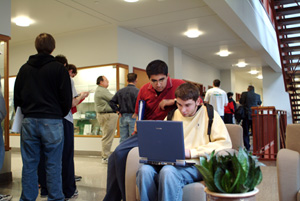Wabash College prides itself on having students deeply involved in their education. Results from a 2004 national survey confirm Wabash men are some of the most engaged students in the nation.
And in one category, Wabash freshmen ranked the level of academic challenge higher than any of the other 472 colleges surveyed.
The 2004 National Survey of Student Engagement (NSSE) reports Wabash College students rank near the top in several categories measuring student involvement.
The NSSE report is based on data collected from 162,000 randomly selected students from 472 four-year colleges and universities. NSSE assesses the extent students are involved in activities which have been linked to high levels of learning and development.
 "We have always admitted students who have shown a high level of involvement from their high school experience," said Dean of the College Mauri Ditzler. "We attract students who are leaders and expect to be engaged. Engagement begins at Wabash College the day a freshman arrives on campus. Students are expected to take charge of their education from that day on."
"We have always admitted students who have shown a high level of involvement from their high school experience," said Dean of the College Mauri Ditzler. "We attract students who are leaders and expect to be engaged. Engagement begins at Wabash College the day a freshman arrives on campus. Students are expected to take charge of their education from that day on."
The survey of comparative data seeks to help educators and others talk about student engagement and its importance to learning. The questionnaire covers five benchmarks of effective educational practices: 1) Level of Academic Challenge; 2) Active and collaborative learning; 3) Student-faculty interactions; 4) Enriching educational experiences; 5) Supportive campus environment.
Assistant Dean of the College Julie Olsen explained the survey is sent to first-year and senior students in the spring of each year. She said approximately 40 percent of Wabash students complete and return the questionnaire.
Wabash men set the national standard in three of five categories for liberal arts colleges. First-year students ranked the level of academic challenge, active and collaborative learning, and enriching educational experiences at the top of the annual survey.
For example, when rating the level of academic challenge, students are asked about class preparation, number of assigned textbooks, number of papers they must write, the difficulty of coursework, and the level of expectation.
"An expectation of involvement is clear to new students," Ditzler said. "The level of involvement becomes clear to them through the Gentleman’s Rule and their co-curricular activities. While taking charge of their own lives, the level of ownership and involvement naturally spills over into our classrooms."
The Gentleman’s Rule states "A Wabash man will conduct himself at all times, both on and off campus, as a gentleman and a responsible citizen." It is the only rule governing Wabash students.
The challenging academic atmosphere and the unique qualities of an all-male campus contribute to the high levels of achievement, believes the Director of the Center of Inquiry in the Liberal Arts Charles Blaich.
"We admit students of exceptional promise but not necessarily exceptional polish," Blaich said. "Then by hard work we transform these young men. There are a lot of small, residential liberal arts colleges around with a good teaching environment and small classes but somehow, maybe it’s because we are a men’s college, our environment seems to be super-charged.
"Our students are working very hard. They are engaged in the kind of learning that seems to be very powerful. That’s a credit to out traditions, our faculty and even to what students are doing with each other in the living units and dormitories. It’s a powerful environment."
One portion of the data that jumped out at all of the Wabash administrators was a statistical look the College’s scores based upon NSSE predicted scores. NSSE created additional data by taking into account the types of students already enrolled at Wabash. Blaich noted Wabash has demographics that wouldn’t necessarily indicate a high score, demographics including being all male, a rural location and a high percentage of minorities.
In all five benchmark areas, Wabash exceeded its predicted score by substantial margins. The college ranks at the top of the survey when Wabash’s scores are compared to its predicted scores and to other NSSE schools.
"Our students often cite faculty involvement as having the biggest impact on their level of engagement," Ditzler said. "Our faculty attends student plays, concerts and athletic events but they go much further by eating with students in our fraternities and Great Hall.
"When students see the faculty at activities outside the classroom, they report it is natural to be engaged in a similar fashion in the classroom."
The NSSE report is co-sponsored by The Carnegie Foundation for the Advancement of Teaching and the Pew Forum on Undergraduate Learning. The NSSE is part of the Center for Postsecondary Research, Indiana University, School of Education.
For more information see: